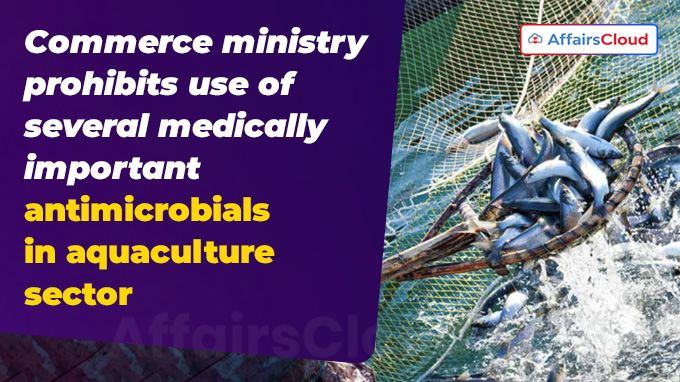 In May 2025, the Department of Commerce(DoC), Ministry of Commerce and Industry (MoC&I), in consultation with the Export Inspection Council(EIC), prohibited the use of several medically important antimicrobials in the Aquaculture sector.
In May 2025, the Department of Commerce(DoC), Ministry of Commerce and Industry (MoC&I), in consultation with the Export Inspection Council(EIC), prohibited the use of several medically important antimicrobials in the Aquaculture sector.
- The prohibition order was issued by the MoC&I under the Export (Quality Control and Inspection) Act, 1963, a legislative framework established to ensure the quality of India’s export commodities through systematic quality control and inspection measures.
- The MoC&I issued an amendment to its principal order, notified on August 21, 1995, in view of the development of export trade in India.
Key Points:
i.Overuse and misuse of antibiotics in food-animal production for the purpose of promoting growth or preventing or controlling diseases, attributes as one of the drivers of Antimicrobial Resistance (AMR).
ii.MoC&I added a list of antibiotics, antivirals and antiprotozoals that are prohibited from being used in culture of Shrimps, prawns or any other variety of fish and fishery products.
- The antimicrobials are prohibited to use in hatcheries, feed manufacturering units and pre-processing or processing units.
iii.MoC&I has banned the use of 12 antibiotic classes and 6 antibiotics, which fall under the antimicrobials authorized only for use in humans, permitted by the World Health Organization (WHO) in its List of Medically Important Antimicrobials for Human Medicine.
- The Antibiotic Classes are Carboxypenicillins, Ureidopenicillins, Combinations of Cephalosporins with beta-lactamase inhibitors, Siderophore Cephalosporins, Carbapenems, Penems, Monobactams, Glycopeptides, Lipopeptides, Oxazolidinones, Glycylcyclines and Phosphonic Acid Derivatives
- Antibiotics are Ceftobiprole, Ceftaroline, Fidaxomicin, Plazomicin, Eravacycline and Omadacycline
- TheWHO list excludes Phosphonic Acid Derivatives, which are authorized for use in both humans and animals and is a High Priority Critically Important Antimicrobial.
iv.The amendment added several new Antibiotics and Antibiotic classes, in addition to the list of 20 pharmacologically active substances that were prohibited by the MoC&I in 2002.
- Glycopeptides, a class of antibiotics, is present in both previous and current list.
v.The existing guidelines and policies in aquaculture were more focused on export-centric fisheries, to avoid rejections in consignment and facilitate smoother exports.
vi.However, there are other Antibiotics which are banned in Aquaculture in view of domestic consumption and public health.
Points to Note:
i.Globally, the use of antimicrobials in aquaculture is substantial, with estimates indicating that 10,259 tonnes of antimicrobials were used worldwide in 2017, and this figure is projected to increase to 13,600 tonnes(t) annually by 2030. The Asia-Pacific region accounts for the largest share of this usage.
ii.India has emerged as a global leader in the fisheries sector, ranking as the second-largest fish producer, contributing approximately 8% to global fish production, and holding the position of the second-largest aquaculture producer after China.
- India is also recognized as the largest producer of shrimp, playing a pivotal role in global seafood markets.
iii.In the Financial Year 2023–24(FY24), India achieved a record-breaking seafood export, shipping 1.78 million tonnes valued at USD 7.38 billion (approximately Rs 60,523.89 crore), marking the highest-ever volume and value in the country’s seafood export history.
About the Ministry of Commerce and Industry (MoC&I):
Union Minister – Piyush Goyal (Constituency – Mumbai North, Maharashtra)
Minister of State (MoS) – Jitin Prasada (Constituency – Pilibhit, Uttar Pradesh, UP)




